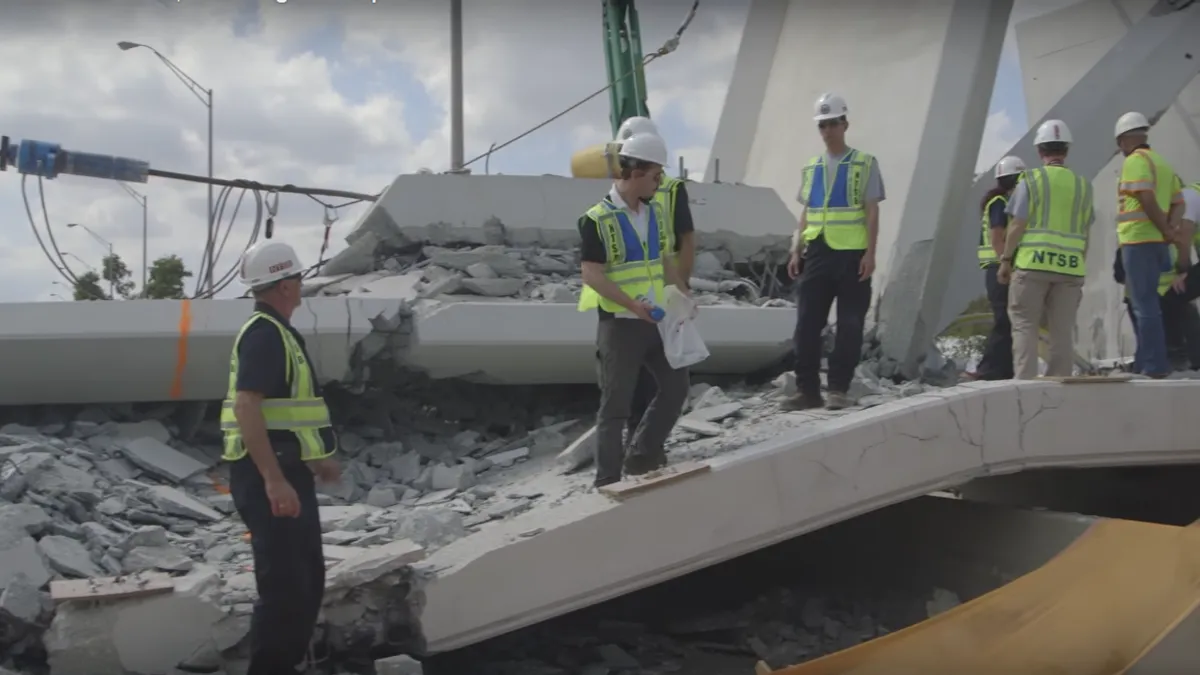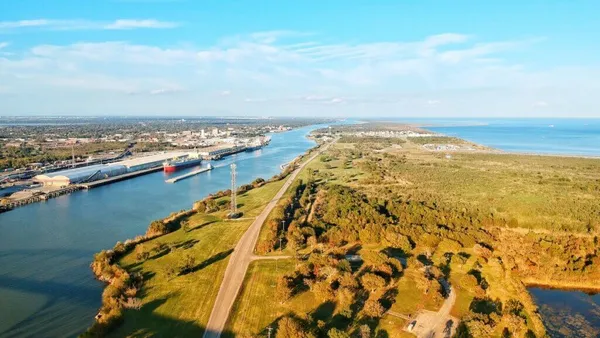On Aug. 9, the National Transportation Safety Board released the latest update on its investigation into the March 15 Florida International University pedestrian bridge collapse. It still, however, isn't ready to identify the probable cause of the structure's failure despite photo evidence of cracks — some fissure-like — in the bridge deck and other areas, presumably that developed after the prefabricated span was set in place just a few days before the fatal incident.
The bridge was transported into position from its offsite location on March 10 to much fanfare, while its building method, accelerated bridge construction, was touted as a way to deliver such structures with minimal interruption to traffic. Five days later, the bridge collapsed onto vehicular traffic below, killing six — one bridge worker and five vehicle occupants — and injuring several others.
The collapse occurred while workers were tightening, or re-tensioning, steel rods at the bridge's north end, including at diagonal member 11, after they were de-tensioned on the day of the move.
In the NTSB's first report, issued on March 21, not even a week after the collapse, the agency outlined the next steps it would take as part of its investigation including: a forensic examination of the bridge's structural elements, destructive testing of core and steel samples and an overall evaluation of the bridge's materials and construction process.
In its latest update, the agency said it had so far conducted post-tensioning rod tests, including a tension test-to-failure on rods from diagonal member 11, tests on round-bar tension-testing specimens and Rockwell C hardness measurements on a cross-section of member 11 and other rods; post-tensioning jack tests for calibration and maximum capacity; and concrete tests — including compression tests using samples from the bridge deck and canopy, tension tests on the bridge deck and an evaluation of six samples from the deck and canopy to determine entrained and entrapped air contents, aggregate content, and cement paste content.
The NTSB said the results thus far have not pointed to any "notable material issues." Further, an examination of the bridge deck near the area of failure, which included use of a 3D laser scanner, determined that the undamaged concrete and embedded reinforcing steel investigators were able to evaluate were in line with the design specifications.
In its March report, the agency also released February-dated photos that showed very minor cracking at the span's north-end diagonal member 11.
In the latest NTSB update, however, the agency included photos that seem to tell a much different story.
After the bridge was set in place atop piers on March 10, March 13-dated photos show that the areas where project officials first identified minor breaks had developed more significant cracking. Vertical member 12, along with diagonal member 11, was located at the north end of the pedestrian bridge where, again, the structure is presumed to have failed.
Additional photos show large cracks at member 12, as well as at the adjacent deck.
A Florida DOT voicemail transcript of a message from an employee of the project engineering firm, FIGG Bridge Engineers, responding to the issue of cracking on March 13 revealed that major project players were aware of the crack but came to the conclusion that they posed no safety issue. In the voicemail, W. Denney Pate, engineer of record, reportedly said, "We've taken a look at it and, obviously some repairs or whatever will have to be done, but from a safety perspective we don't see that there's any issue there, so we're not concerned about it from that perspective, although obviously the cracking is not good and something's going to have to be … done to repair that."
On the morning of the collapse, according to FIU, Pate once again gave his opinion that cracking wasn't a safety concern in a meeting with general contractor Munilla Construction Management and officials from the FDOT and FIU.
The NTSB offered no commentary on the cracks, but Linwood Howell, a bridge engineer from Texas who is not affiliated with the FIU project, told the Miami Herald that the degree of cracking was "shocking" and signs that "the bridge is clearly failing."
William L. Gamble, professor emeritus of civil and environmental engineering at the University of Illinois in Urbana, offered similar comments to Engineering News-Record. Gamble told ENR that he was astonished that anyone who had ever taken a course on reinforced concrete could have dismissed them as anything other than "deadly serious" and that if similar cracks appeared in a building, the occupants would have been advised to "run, don't walk, to the nearest exit."
The NTSB will continue its investigation, it said, with the intent of not only providing an answer to the cause of the collapse but to prevent future similar incidents.














